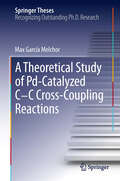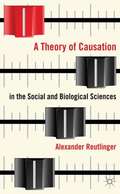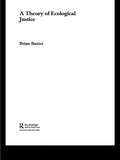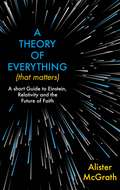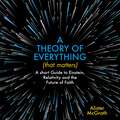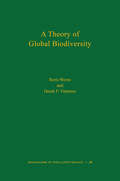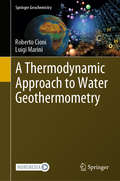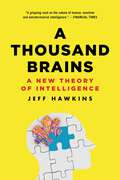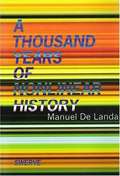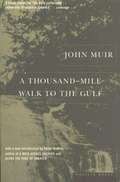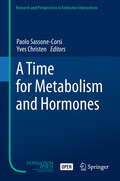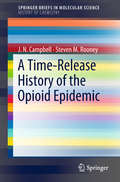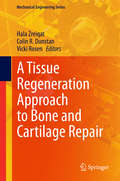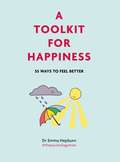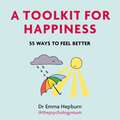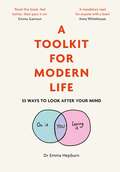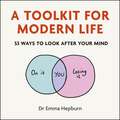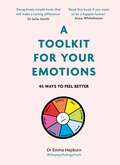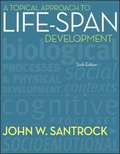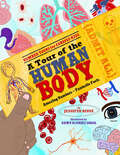- Table View
- List View
A Theoretical Study of Pd-Catalyzed C-C Cross-Coupling Reactions (Springer Theses)
by Max García MelchorFind out how theoretical calculations are used to determine, elucidate and propose mechanisms for Pd-catalyzed C-C cross-coupling reactions in Max Garcia Melchor's outstanding thesis. Garcia Melchor investigates one of the most significant and useful types of reactions in modern organic synthesis; the Pd-cross coupling reaction. Due to its versatility, broad scope and selectivity under mild conditions, this type of reaction can now be applied in fields as diverse as the agrochemical and pharmaceutical industry. Garcia Melchor studies the reaction intermediates and transition states involved in the Negishi, the copper-free Sonogashira and the asymmetric version of Suzuki-Miyaura coupling. He also characterizes and provides a detailed picture of the associated reaction mechanisms. The author has won numerous prizes for this work which has led to over eight publications in internationally renowned journals.
A Theory of Causation in the Social and Biological Sciences
by Alexander ReutlingerThis first full length treatment of interventionist theories of causation in the social sciences, the biological sciences and other higher-level sciences the presents original counter arguments to recent trends in the debate and serves as useful introduction to the subject.
A Theory of Ecological Justice (Environmental Politics #Vol. 8)
by Brian BaxterIn A Theory of Ecological Justice, Baxter argues for ecological justice - that is, for treating species besides homo sapiens as having a claim in justice to a share of the Earth's resources. It explores the nature of justice claims as applied to organisms of various degrees of complexity and describes the institutional arrangements necessary to integrate the claims of ecological justice into human decision-making.
A Theory of Everyone: The New Science of Who We Are, How We Got Here, and Where We’re Going
by Michael MuthukrishnaA blueprint for a better future that offers a unified theory of human behavior, culture, and society.Playing on the phrase &“a theory of everything&” from physics, Michael Muthukrishna&’s ambitious, original, and deeply hopeful book A Theory of Everyone draws on the most recent research from across the sciences, humanities, and the emerging field of cultural evolution to paint a panoramic picture of who we are and what exactly makes human beings different from all other forms of life on the planet. Muthukrishna argues that it is our unique ability to create culture, a shared body of knowledge, skills, and experience passed on from generation to generation, that has enabled our current dominance. But it is only by understanding and applying the laws of life—the need for energy, innovation, cooperation, and evolution—that we can solve the practical and existential challenges we face as a species. A Theory of Everyone attempts to provide solutions for the most pressing problems of our collective future, such as polarization, inequality, the &“great stagnation&” in productivity, and the energy crisis.Casting a bold and wide net, Muthukrishna&’s book is a must-read for anyone interested in a better future for ourselves and for generations to come.
A Theory of Everything (That Matters): A Short Guide to Einstein, Relativity and the Future of Faith
by Dr Alister E McGrathOn 29th May 1919, British astronomers tested Einstein's theory of relativity by measuring the path of the stars travelling near the sun during an eclipse. On 7th November 1919, the results of that experiment were announced in London, proving Einstein's theory of relativity. A Theory of Everything (that Matters) has been written in celebration of this 100th anniversary. With the confirmation of Einstein's theories at the beginning of the twentieth century, our understanding of the universe became much more complex. What does this mean for religious belief, and specifically Christianity? Does it mean, as so many people assume, the death of God? In A Theory of Everything (that Matters) Alister McGrath - Professor of Science and Religion at Oxford University - explores these questions, giving an overview of Einstein's thought and scientific theories, including his nuanced thinking on the difference between the scientific enterprise and beliefs outside its realm. This groundbreaking book is for anyone intrigued by Einstein as one of the twentieth century's most iconic figures, who wants to know what his theories mean for religion, and who is interested in the conversation between science and religions more broadly.'An excellent study of Einstein's theories in relation to his beliefs about God' - starred review in PUBLISHERS WEEKLY
A Theory of Everything (That Matters): A Short Guide to Einstein, Relativity and the Future of Faith
by Dr Alister E McGrathAn overview of Einstein's theories and what they mean for Christian belief, published on the 100th anniversary of the confirmation of the theory of relativity.On 29th May 1919, British astronomers tested Einstein's theory of relativity by measuring the path of the stars travelling near the sun during an eclipse. On 7th November 1919, the results of that experiment were announced in London, proving Einstein's theory of relativity. A Theory of Everything (that Matters) has been written in celebration of this 100th anniversary. With the confirmation of Einstein's theories at the beginning of the twentieth century, our understanding of the universe became much more complex. What does this mean for religious belief, and specifically Christianity? Does it mean, as so many people assume, the death of God? In A Theory of Everything (that Matters) Alister McGrath - Professor of Science and Religion at Oxford University - explores these questions, giving an overview of Einstein's thought and scientific theories, including his nuanced thinking on the difference between the scientific enterprise and beliefs outside its realm. This groundbreaking book is for anyone intrigued by Einstein as one of the twentieth century's most iconic figures, who wants to know what his theories mean for religion, and who is interested in the conversation between science and religions more broadly.(P) 2019 Hodder & Stoughton Ltd
A Theory of Global Biodiversity (Monographs in Population Biology #79)
by Boris Worm Derek TittensorThe number of species found at a given point on the planet varies by orders of magnitude, yet large-scale gradients in biodiversity appear to follow some very general patterns. Little mechanistic theory has been formulated to explain the emergence of observed gradients of biodiversity both on land and in the oceans. Based on a comprehensive empirical synthesis of global patterns of species diversity and their drivers, A Theory of Global Biodiversity develops and applies a new theory that can predict such patterns from few underlying processes. The authors show that global patterns of biodiversity fall into four consistent categories, according to where species live: on land or in coastal, pelagic, and deep ocean habitats. The fact that most species groups, from bacteria to whales, appear to follow similar biogeographic patterns of richness within these habitats points toward some underlying structuring principles. Based on empirical analyses of environmental correlates across these habitats, the authors combine aspects of neutral, metabolic, and niche theory into one unifying framework. Applying it to model terrestrial and marine realms, the authors demonstrate that a relatively simple theory that incorporates temperature and community size as driving variables is able to explain divergent patterns of species richness at a global scale. Integrating ecological and evolutionary perspectives, A Theory of Global Biodiversity yields surprising insights into the fundamental mechanisms that shape the distribution of life on our planet.
A Theory of the Basal Ganglia and Their Disorders (Conceptual Advances in Brain Research)
by Robert MillerThe Basal ganglia, to adopt a phrase of Churchill's, are "a riddle wrapped in a mystery, inside an enigma." And although there is a wealth of information available on them, this research field remains controversial due in part to the diverse number of disciplines involved. A Theory of the Basal Ganglia and Their Disorders provides a clear, coherent
A Thermodynamic Approach to Water Geothermometry (Springer Geochemistry)
by Roberto Cioni Luigi MariniThis book explores water geothermometry, a highly relevant topic in the exploration and exploitation of geothermal energy. Presenting theoretical geothermometers and indicators of CO2 fugacity, it describes a rigorous new approach entirely based on thermodynamics. The book will appeal to geothermal geoscientists, especially those working in research institutions and companies around the globe. It is also of interest to students on advanced courses in applied geochemistry, water–rock interaction and other related areas.
A Thousand Brains: A New Theory of Intelligence
by Jeff HawkinsA bestselling author, neuroscientist, and computer engineer unveils a theory of intelligence that will revolutionize our understanding of the brain and the future of AI. For all of neuroscience's advances, we've made little progress on its biggest question: How do simple cells in the brain create intelligence? Jeff Hawkins and his team discovered that the brain uses maplike structures to build a model of the world-not just one model, but hundreds of thousands of models of everything we know. This discovery allows Hawkins to answer important questions about how we perceive the world, why we have a sense of self, and the origin of high-level thought. A Thousand Brains heralds a revolution in the understanding of intelligence. It is a big-think book, in every sense of the word.
A Thousand Years of Nonlinear History
by Manuel De LandaFollowing in the wake of his groundbreaking War in the Age of Intelligent Machines, Manuel De Landa presents a radical synthesis of historical development over the last one thousand years. More than a simple expository history, A Thousand Years of Nonlinear History sketches the outlines of a renewed materialist philosophy of history in the tradition of Fernand Braudel, Gilles Deleuze, and Félix Guattari, while also engaging the critical new understanding of material processes derived from the sciences of dynamics. Working against prevailing attitudes that see history as an arena of texts, discourses, ideologies, and metaphors, De Landa traces the concrete movements and interplays of matter and energy through human populations in the last millennium. De Landa attacks three domains that have given shape to human societies: economics, biology, and linguistics. In every case, what one sees is the self-directed processes of matter and energy interacting with the whim and will of human history itself to form a panoramic vision of the West free of rigid teleology and naive notions of progress, and even more important, free of any deterministic source of its urban, institutional, and technological forms. Rather, the source of all concrete forms in the West's history are shown to derive from internal morphogenetic capabilities that lie within the flow of matter-energy itself.
A Thousand-Mile Walk to the Gulf
by John Muir William Frederic BadeTaken from Muir's earliest journals, this book records his walk in 1867 from Indiana across Kentucky, Tennessee, North Carolina, Georgia and Florida to the Gulf Coast. In his distinct and wonderful style, Muir shows us the wilderness, as well as the towns and people, of the South immediately after the Civil War. Foreword by Peter Jenkins.
A Time Apart
by Diane StanleyWhile her mother undergoes treatment for cancer, thirteen-year-old Ginny is sent to live with her father in England. Once there, she becomes part of an archaeological experiment that investigates life during the iron age.
A Time for Metabolism and Hormones (Research and Perspectives in Endocrine Interactions)
by Yves Christen Paolo Sassone-CorsiRecent years have seen spectacular advances in the field of circadian biology. These have attracted the interest of researchers in many fields, including endocrinology, neurosciences, cancer, and behavior. By integrating a circadian view within the fields of endocrinology and metabolism, researchers will be able to reveal many, yet-unsuspected aspects of how organisms cope with changes in the environment and subsequent control of homeostasis. This field is opening new avenues in our understanding of metabolism and endocrinology. A panel of the most distinguished investigators in the field gathered together to discuss the present state and the future of the field. The editors trust that this volume will be of use to those colleagues who will be picking up the challenge to unravel how the circadian clock can be targeted for the future development of specific pharmacological strategies toward a number of pathologies.
A Time-Release History of the Opioid Epidemic (SpringerBriefs in Molecular Science)
by Steven M. Rooney J. N. CampbellThis Brief takes the reader on a chemical journey by following the history for over two centuries of how an opiate became an opioid, thus spawning an empire and a series of crises. These imperfect resemblances of alkaloids are both natural and synthetic substances that, particularly in America, are continually part of a growing concern about overuse. This seemed an inviting prospect for those in pain, but as the ubiquitous media coverage continues to lay bare, the levels of abuse point to the fact that perhaps an epidemic is upon us, if not a culture war. Seeking answers to how and why this addiction crisis transpired over two hundred years of long development, this Brief examines the role that the chemistry laboratory played in turning patients into consumers. By utilizing a host of diverse sources, this Brief seeks to trace the design and the production of opioids and their antecedents over the past two centuries. From the isolation and development of the first alkaloids with morphine that relieved pain within the home and on the battlefield, to the widespread use of nostrums and the addiction crisis that ensued, to the dissemination of drugs by what became known as Big Pharma after the World Wars; and finally, to competition from home-made pharmaceuticals, the progenitor was always, in some form, a type of chemistry lab. At times, the laboratory pressed science to think deeply about society's maladies, such as curing disease and alleviating pain, in order to look for new opportunities in the name of progress. Despite the best intentions opioids have created a paradox of pain as they were manipulated by creating relief with synthetic precision and influencing a dystopian vision. Thus, influence came in many forms, from governments, from the medical community, and from the entrepreneurial aspirations of the general populace. For better, but mostly for worse, all played a role in changing forever the trajectory of what started with the isolation of a compound in Germany. Combining chemistry and history in a rousing new long-form narrative that even broadens the definition of a laboratory, the origins and future of this complicated topic are carefully examined.
A Tissue Regeneration Approach to Bone and Cartilage Repair (Mechanical Engineering Series)
by Vicki Rosen Hala Zreiqat Colin R. DunstanReviewing exhaustively the current state of the art of tissue engineering strategies for regenerating bones and joints through the use of biomaterials, growth factors and stem cells, along with an investigation of the interactions between biomaterials, bone cells, growth factors and added stem cells and how together skeletal tissues can be optimised, this book serves to highlight the importance of biomaterials composition, surface topography, architectural and mechanical properties in providing support for tissue regeneration. Maximizing reader insights into the importance of the interplay of these attributes with bone cells (osteoblasts, osteocytes and osteoclasts) and cartilage cells (chondrocytes), this book also provides a detailed reference as to how key signalling pathways are activated. The contribution of growth factors to drive tissue regeneration and stem cell recruitment is discussed along with a review the potential and challenges of adult or embryonic mesenchymal stem cells to further enhance the formation of new bone and cartilage tissues. This book serves to demonstrate the interconnectedness of biomaterials, bone/cartilage cells, growth factors and stem cells in determining the regenerative process and thus the clinical outcome.
A Toolkit for Happiness: 55 Ways to Feel Better
by Dr Emma Hepburn'Mandatory for anyone with a brain' - Anna Whitehouse, founder of Mother Pukka'Relatable, practical and knowledgeable' - Gemma Bray, creator of The Organised Mum Method From clinical psychologist and author of A Toolkit for Modern Life, Dr Emma Hepburn, comes A Toolkit for Happiness - the ultimate guide to long-term and sustainable happiness.Using her much-loved trademark illustrations, Dr Hepburn arms us with 55 accessible and easy-to-use tools to boost our moods and feel better. She teaches us that happiness is as much about weathering the storms of life, accepting its natural ebbs and flows, as it is about enjoying the sunny weather - and that by implementing small and simple changes we can build a more compassionate brain that carries us through our daily lives, no matter the weather.From practical tools to aid you on those extra stormy days to thought-provoking exercises for your day-to-day mental wellbeing, A Toolkit for Happiness will you to cultivate positive habits, better understand your emotions and put you on the path to a healthier and happier you.
A Toolkit for Happiness: 55 Ways to Feel Better
by Dr Emma Hepburn'Mandatory for anyone with a brain' - Anna Whitehouse, founder of Mother Pukka'Relatable, practical and knowledgeable' - Gemma Bray, creator of The Organised Mum Method From clinical psychologist and author of A Toolkit for Modern Life, Dr Emma Hepburn, comes A Toolkit for Happiness - the ultimate guide to long-term and sustainable happiness.Using her much-loved trademark illustrations, Dr Hepburn arms us with 55 accessible and easy-to-use tools to boost our moods and feel better. She teaches us that happiness is as much about weathering the storms of life, accepting its natural ebbs and flows, as it is about enjoying the sunny weather - and that by implementing small and simple changes we can build a more compassionate brain that carries us through our daily lives, no matter the weather.From practical tools to aid you on those extra stormy days to thought-provoking exercises for your day-to-day mental wellbeing, A Toolkit for Happiness will you to cultivate positive habits, better understand your emotions and put you on the path to a healthier and happier you.
A Toolkit for Happiness: 55 Ways to Feel Better
by Emma Hepburn'Mandatory for anyone with a brain' - Anna Whitehouse, founder of Mother Pukka'Relatable, practical and knowledgeable' - Gemma Bray, creator of The Organised Mum Method From clinical psychologist and author of A Toolkit for Modern Life, Dr Emma Hepburn, comes A Toolkit for Happiness - the ultimate guide to long-term and sustainable happiness.Using her much-loved trademark illustrations, Dr Hepburn arms us with 55 accessible and easy-to-use tools to boost our moods and feel better. She teaches us that happiness is as much about weathering the storms of life, accepting its natural ebbs and flows, as it is about enjoying the sunny weather - and that by implementing small and simple changes we can build a more compassionate brain that carries us through our daily lives, no matter the weather.From practical tools to aid you on those extra stormy days to thought-provoking exercises for your day-to-day mental wellbeing, A Toolkit for Happiness will you to cultivate positive habits, better understand your emotions and put you on the path to a healthier and happier you.
A Toolkit for Modern Life: 53 Ways to Look After Your Mind
by Dr Emma Hepburn'Emma has a unique way of cutting through to the heart of the issues we all face day-in-day-out. There isn't another book out there like this and it should be a mandatory read for anyone with a brain.' - Anna Whitehouse, founder of Mother Pukka In this warm, wise book, clinical psychologist Dr Emma Hepburn (Instagram's @thepsychologymum) introduces her proven and practical tools for taking care of your mental and emotional wellbeing every day.Using her trademark illustrations, Dr Hepburn (aka @thepsychologymum) shines a welcome ray of light into the neglected corners of your brain. From identifying what triggers unhappy thoughts to overcoming the fear of making mistakes, A Toolkit for Modern Life will help you to cultivate positive habits and feel more confident, happier and in tune with yourself.* Call out and manage feelings of imposter syndrome* Answer back to your inner critic* Become aware of and monitor your emotional capacity* Spot unhelpful thoughts and develop more helpful patterns of thinking* Understand how the emotions cycle affects you* Identify what triggers anxiety for you and how to intercept it* Overcome the fear of making mistakes* Spot and call out your 'catastrophizing'* Identify and disarm social media comparisons* Align your decisions and actions with your core values* Assemble your own mental health toolkit for life
A Toolkit for Modern Life: 53 Ways to Look After Your Mind
by Dr Emma Hepburn'Emma has a unique way of cutting through to the heart of the issues we all face day-in-day-out. There isn't another book out there like this and it should be a mandatory read for anyone with a brain.' - Anna Whitehouse, founder of Mother PukkaIn this warm, wise audiobook, clinical psychologist Dr Emma Hepburn talks you through her proven and practical tools for taking care of your mental and emotional wellbeing every day.Let Dr Hepburn (Instagram's @thepsychologymum) shine a welcome ray of light into the neglected corners of your brain. From identifying what triggers unhappy thoughts to overcoming the fear of making mistakes, A Toolkit for Modern Life will help you to cultivate positive habits and feel more confident, happier and in tune with yourself.* Call out and manage feelings of imposter syndrome* Answer back to your inner critic* Become aware of and monitor your emotional capacity* Spot unhelpful thoughts and develop more helpful patterns of thinking* Understand how the emotions cycle affects you* Identify what triggers anxiety for you and how to intercept it* Overcome the fear of making mistakes* Spot and call out your 'catastrophizing'* Identify and disarm social media comparisons* Align your decisions and actions with your core values* Assemble your own mental health toolkit for life(P)2020 Quercus Editions Limited
A Toolkit for Modern Life: 53 Ways to Look After Your Mind
by Emma Hepburn'Emma has a unique way of cutting through to the heart of the issues we all face day-in-day-out. There isn't another book out there like this and it should be a mandatory read for anyone with a brain.' - Anna Whitehouse, founder of Mother Pukka In this warm, wise book, clinical psychologist Dr Emma Hepburn (Instagram's @thepsychologymum) introduces her proven and practical tools for taking care of your mental and emotional wellbeing every day.Using her trademark illustrations, Dr Hepburn (aka @thepsychologymum) shines a welcome ray of light into the neglected corners of your brain. From identifying what triggers unhappy thoughts to overcoming the fear of making mistakes, A Toolkit for Modern Life will help you to cultivate positive habits and feel more confident, happier and in tune with yourself.* Call out and manage feelings of imposter syndrome* Answer back to your inner critic* Become aware of and monitor your emotional capacity* Spot unhelpful thoughts and develop more helpful patterns of thinking* Understand how the emotions cycle affects you* Identify what triggers anxiety for you and how to intercept it* Overcome the fear of making mistakes* Spot and call out your 'catastrophizing'* Identify and disarm social media comparisons* Align your decisions and actions with your core values* Assemble your own mental health toolkit for life
A Toolkit for Your Emotions: 45 ways to feel better
by Dr Emma HepburnIn A Toolkit for Your Emotions, Emma takes a deep dive into how we feel and explains all the tools you need to intercept and redirect challenging emotion. From joy to anger, shame to stress and anxiety, Emma has practical and effective ways to feel instantly calmer and more content.Each topic is illustrated with Emma's well-loved illustration to make them accessible, meaningful and memorable. Dr Emma Hepburn is the most well-known psychologist on Instagram (@thepsychologymum, 135k followers) and has won numerous awards for her contribution to mental health awareness.
A Topical Approach To Life-span Development, 6th Ed.
by John SantrockConnect with Santrock 6th edition and connect with success. Informed and driven by research. At McGraw-Hill, we have spent thousands of hours with you and your students, working to understand the key needs and concerns you face in Human Development courses. The most common topics raised include managing the vast amount of content inherent to a Lifespan course and ensuring the dependability of the assigned material–is it current and accurate? The result of this research is John Santrock's A Topical Approach to Lifespan Development 6e. Santrock 6e ensures students complete and understand the assigned material in a number of ways. Santrock's hallmark Learning Goals pedagogy provides a comprehensive roadmap to the text material, clearly pointing out the core concepts fundamental to students' learning and performance. An adaptive learning system increases students' efficiency in studying by identifying what they know and don't know and providing in-the-moment guides to learning what they do not. The research and development of the 6th edition indicated that students said that highlighting connections among the different aspects of life-span development would help them to better understand the concepts. This recurring theme of connections–Developmental Connections, Topical Connections, Connecting Development to Life, Connecting with Careers, and Connections through Research–ties together concepts from across chapters to reinforce the learning process and connects the material to students' everyday lives and future aspirations. And the new Milestones video and assessment program helps bring the course material to life, so your students can witness development as it unfolds. And of course, all of this material is informed by our unique board of expert contributors–a who's who of developmental psychology–who ensure the material is as accurate and up-to-date as possible.
A Tour of the Human Body: Amazing Numbers--Fantastic Facts (Number Tours for Curious Kids)
by Jennifer BerneJennifer Berne takes children on a tour of the human body to reveal the wonders of how it works -- with some astonishing numbers and fascinating facts along the way.From our eyes to our toes, kids will find out what makes the human body tick. They&’ll discover that our hearts beat 100,000 times a day, which equals 36 MILLION times a year. And that our tongue&’s 8,000 taste buds can detect only 5 flavors. And that we have 60,000 miles of blood vessels, enough to circle the world more than twice!With such remarkable facts and numbers, and vivid informative illustrations by Dawn DeVries Sokol, this book takes your child on an entertainingly educational journey through the wonders of the human body.
